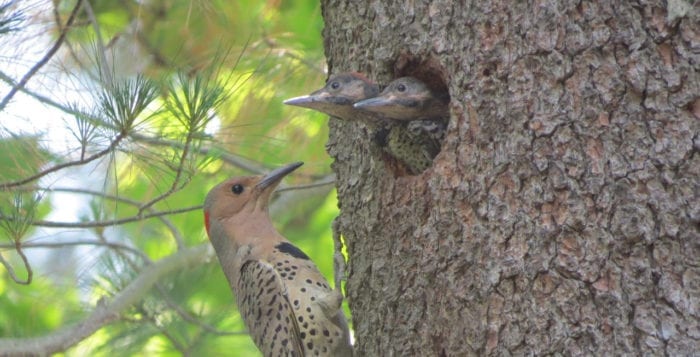By John Turner
When it comes to cavities it’s all about the type. A large cavity in your molar? A trip to the dentist because it’s a problem you need to have treated immediately. A deep cavity in the road you travel on the way to the dentist? Worth a phone call to the superintendent of highways before it destroys tires and rims.
But cavities in a living white oak or dead pitch pine in an unused back corner of your property? Priceless assets appreciated by many species of birds, mammals and insects that nest or roost in them. This point is emphasized by the fact that more than 60 North American birds, mammals and reptiles use tree cavities of various sizes to roost or nest in, underscoring their fundamental importance in maintaining ecological balance.
Cavity-using bird species include black-capped chickadees (a tiny bird beloved by many), titmice, nuthatches, screech owls (fairly common in the woodlands of the Three Village area), all species of woodpeckers, a few ducks, several species of bats, gray and flying squirrels, raccoons, opossums, mice and several species of tree-climbing snakes. Add to this many dozens of insects including bees that use cavities too.
Cavities are such coveted features that species often compete for them. I once watched a several-days battle take place at my house between two woodpecker species — a red-bellied woodpecker and a northern flicker — and a European starling, all vying for a cavity in a large red maple tree on the far edge of the driveway, observable from a second-story window. The flicker had established first rights to it but was usurped by a pair of starlings as the day went on. But with great drama the flicker fought back and the next day had reclaimed ownership. The skirmish continued and the starlings reclaimed it, but then the red-bellied showed up, evicting the starlings. The red-bellied was the final victor and subsequently raised a family in the maple tree.
Woodpeckers play a prominent role in the tree cavity rental market since they make and use so many cavities that other wildlife eventually use (others are created by decay through fungal rot such as when a branch breaks off at the main trunk).
The bigger woodpeckers — the aforementioned flicker and red-bellied — and the hairy and red-headed are especially adept in chiseling into the live wood to make cavities, the diminutive downy woodpecker not so much. Because of the cavity-making role woodpeckers play, and the reliance of so many wildlife species on cavities, woodpeckers are referred to as “ecological architects,” helping to shape the faunal composition of local forests.
Two cavity-nesting birds are worth mentioning. Eastern screech owls routinely use cavities and, in fact, are dependent on them for roosting and nesting. It is not unusual but always a delightful surprise to find one sitting at the entrance to a nest hole doing its best impression of tree bark. We have two different color morphs or forms — gray and rufous — and they are both cryptically colored. These small owls, which don’t screech but rather have a tremolo-like call, are probably found in every woodland patch of five acres or more in the area.
As mentioned earlier even some ducks use nesting cavities. Wood ducks, for example, nest in tree cavities, as do hooded mergansers, buffleheads and American goldeneyes. Hooded mergansers can be seen in the pond at Setauket’s Frank Melville Memorial Park during the winter and buffleheads in places like Setauket and Port Jefferson Harbor during the same time. Goldeneyes are winter ducks that are often seen floating on Long Island Sound. But wood ducks breed here and you might be lucky enough to see these spectacular looking birds (the male meets the avian definition of eye candy) at Frank Melville Park and other freshwater bodies in the area.
How do fluffy wood duck ducklings leave the cavity and follow their mother to the local pond to feed? You may have seen the answer on one of the nature shows on TV in which the babies, encouraged by the piping call of the parents, fearlessly launch themselves from the lip of the cavity into the air, making a 30- to 40-foot plunge to the ground below.
Many cavities are in trees that are dead or failing, although living trees sport their share. If the tree poses no danger to property or hasn’t the potential to land on your or your loved one’s head, consider leaving it in place. Not only might it become a wildlife condominium through time as it becomes pocked with cavities, it also becomes a cafeteria for wildlife. Many insects such as beetles are drawn to decaying wood, and they play a key role in recycling wood in forests, releasing nutrients and minerals to be used by living plants nearby. In the form of grubs, the beetles and other insects become food for birds.
So, if a dead tree, containing nesting cavities, presents a danger, by all means protect your head and house. But if it doesn’t threaten life or property, why not take a small step to protect your little area of planet Earth by leaving dead trees in place? You might even be rewarded by the call of a screech owl.
John Turner, a Setauket resident, is conservation chair of the Four Harbors Audubon Society, author of “Exploring the Other Island: A Seasonal Nature Guide to Long Island” and president of Alula Birding & Natural History Tours.





